Books
Books

Pfeil Magazine #9 – Error
The meaning of the word ‘error’, in its origin, is neutral. In Latin ‘errare’ means both ‘to wander freely’ and ‘to wander from the right path’. After the seventeenth century, however, the word ‘error’ lost its ambiguity within English usage and became clearly understood as wrongdoing, as defect, as a way of missing a desired effect. The ninth issue of Pfeil Magazine focuses on the potential of erroneous processes to redefine the meaning of malfunction and takes a look at movements that are aimless or non-productive. Through this reflection, ‘error’ is introduced once again as the possibility of wandering freely.
Contributions by: Mitchell Anderson, Christiane Blattmann, Adam Christensen, Tyler Coburn, Hans-Christian Dany, Michael Dean, Gina Fischli, Flaka Haliti, Laëtitia Badaut Haussmann, Lina Hermsdorf, Judith Hopf, Karl Larsson, Clare Molloy, Susan Morgan and Thomas Lawson, Mense Reents, Stacy Skolnik, Paul Spengemann, Ramaya Tegegne
Editors: Anja Dietmann, Nadine Droste

Pfeil Magazine #10 – Mainstream
Within the format of a magazine, each page of Pfeil represents the floor, walls, or ceiling which together create an imagined room displaying a printed exhibition. Each issue is dedicated to a specific word, and artists are invited and given space to work on and with this term, and to construct or deconstruct the architecture around it. Combined, the contributions transform into an organic display surrounding the leitmotif.
The tenth issue is dedicated to Mainstream, this volume questions exercised motions of majorities, practiced over long or short distances and timeframes, that can become patterns, sometimes taken for granted, sometimes followed unconsciously, automatically, or even mechanically.
Contributions by: Alice Creischer, Annette Kelm, Charlotte Simon, Dodo Voelkel, Emily Pope, Hans-Christian Dany, Harry Gamboa Jr., Heike-Karin Föll, Holly White, Jan Matthé, Jannis Marwitz, Karl Holmqvist, Kevin Gallagher, Lars Bang Larsen, Magdalena Los, Marina Pinsky, Merle Radtke, Nicola Gördes, Pablo Schlumberger, Penny Goring and Stella Rossié.
Editor: Anja Dietmann

Sirens
‘Masturbation in between the crimes against you will become a deciding matter in the kangaroo court. Philosophical questions will be answered without inquiry.’
If you have ever wondered how a cross between a funding application gone wrong and a tabloid column about the art world would read, this is it. Mellor presents a unique combination of novel and image, creating a polymorphous narrator who moves between personifications. Perhaps the most hazardous of these is Tippy Rampage, who is satisfyingly livid with the state of, well, everything.
In a series of paintings, female police officers from British television shows such as Happy Valley and The Bill are positioned in an array of apocalyptic settings: freezing, burning, and backdropped by flooding. The accompanying text chronicles an acute feeling of being watched, what it feels like to watch whoever is watching you, or, as Mellor writes, how it feels to be kettled in your own flat, by your own paintings.
Fragmented accounts map the protagonist’s shifting relationship to crime, gender, class and sexuality from multiple perspectives: as a child in Gamesley in the ‘70s, a lesbian performer in sex clubs in the mid ‘90s, an artist with and without gallery representation, and as a lecturer within an academic institution. These changes of position mix the language of a rally cry with an acerbic satire of the authorial voice and everyone they encounter.
Published by Montez Press, Sirens is the first novel by Dawn Mellor and includes the complete set of the Sirens paintings.
Dawn Mellor (b.1970) is an artist based in London, who has been exhibiting internationally since the 1990s. Solo exhibitions and special projects include Sixty Years at Tate Britain; London, Vile Affections at Studio Voltaire; London, Dawn Mellor at The Migros Museum; Zurich, Sirens at Team Gallery; New York, Madame X and The Party Tricks at Victoria Miro; London, Michael Jackson On The Wall at The National Portrait Gallery; London (touring), What Happened to Helen? Focal Point Gallery; Southend and Malerei, Böse at Kunstverein; Hamburg.
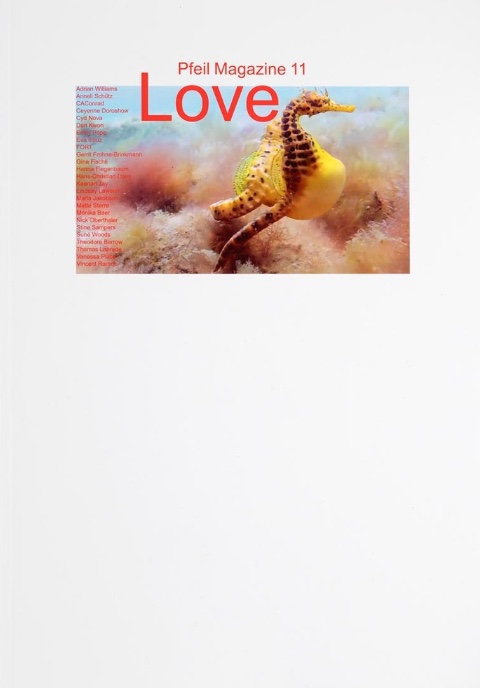
Pfeil Magazine #11 – Love
The eleventh issue of Pfeil Magazine looks into the multitude of meanings behind the word love: a positive affection and strong physical feeling which can be addressed to a friend, family, food, God, an object, or to an amorous partner or partners. Furthermore, it questions the expectations which go along with love, whether that love is returned or unanswered. Relationship patterns and role distributions are surveyed, vulnerabilities are assessed, but besides that the Love issue is also about a pregnant male seahorse, an infatuation with a smiling rock, sports and much more.
Contributors: Adrian Williams, Anneli Schütz, CAConrad, Ceyenne Doroshow, Cyd Nova, Dan Kwon, Emily Pope, Eva Illouz, FORT, Gerrit Frohne-Brinkmann, Gina Fischli, Hanna Fiegenbaum, Hans-Christian Dany, Keenan Jay, Maria Jakobsen, Mette Sterre, Monika Baer, Nick Oberthaler, Lindsay Lawson, Stine Sampers, Suné Woods, Theodore Barrow, Thomas Laprade, Vanessa Place and Vincent Ramos.

The Interjection Calendar 005
Emily Pope, Christiane Blattmann
For the Interjection Calendar each month Montez Press invites an artist, a writer, a poet or a doer of some sorts to say things. All 12 pieces have introspection and reflection in common. They are a subjective overview of writing in the expanded field of contemporary art and writing in the year 2019. This is the Interjection Calendar 2019, the fifth collection in this series.
With contributions by sabrina soyer, Lisa Robertson, Hatty Nestor, Adrianna Whittingham, Sondria, Claudia Pagès, Laetitia Paviani, Bella Milroy, Georgina Tyson, Son Kit, Alix Jean Vollum, Rene Matic and bleubaglife.
Find the last 12 PDF's on montezpress.com.
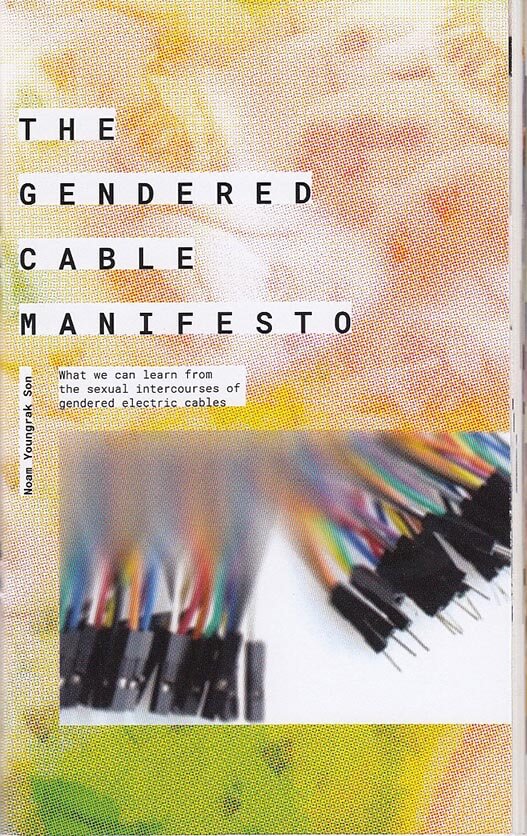
The Gendered Cable Manifesto
"Gender as a concept is not only applicable to humans. When the idea of gender is applied to the cables, its meaning is reduced into a relationship of insertion. As a non-binary individual and designer, I find this problematic that such way of classifying gender violently erases the existence of everyone that doesn’t neatly fit into those categories. However, instead of insisting on abolishing those terms, I discovered that the idea of gender that we applied to the electric cables functioning in very queer ways that we couldn’t expect." More on www.d-act.org.

Neighbor
Neighbor’s mutable, shifty narrator alternately reifies and attempts to refuse the constricting, separating, culture-load bearing wall between lovers and neighbors. As antagonisms and intimacies converge, Levitsky troubles the divisions within urban space, and between spatial and ethical frames: “I live on a street where / people turn (on) each other / into a theory.”
This second edition, printed a decade after Neighbor‘s original publication, features an expanded version of the play, “Perfect California: A Family Affair.”
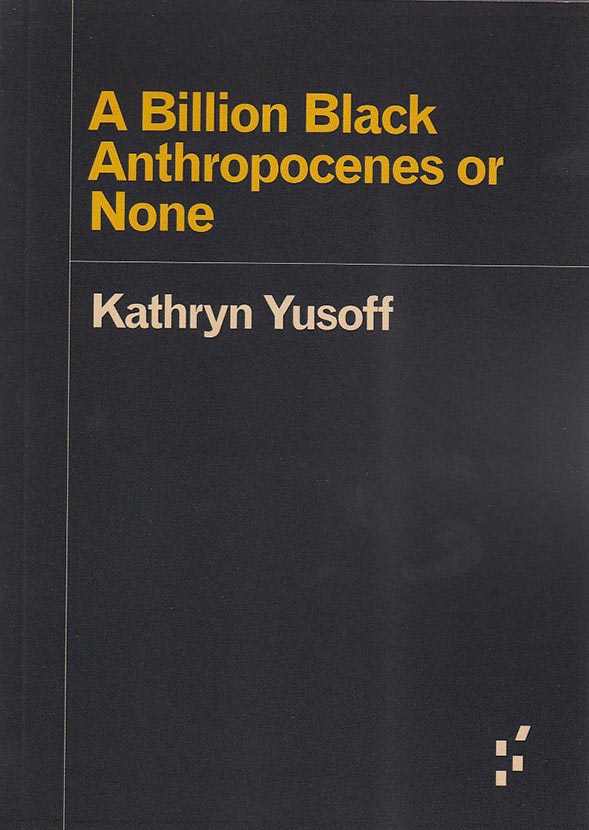
A Billion Black Anthropocenes or None
Tracing the color line of the Anthropocene, A Billion Black Anthropocenes or None examines how the grammar of geology is foundational to establishing the extractive economies of subjective life and the earth under colonialism and slavery. Yusoff initiates a transdisciplinary conversation between feminist black theory, geography, and the earth sciences, addressing the politics of the Anthropocene within the context of race, materiality, deep time, and the afterlives of geology.

Writing Scores / Bubble Score / Perform Back Score / Scorescapes (set)
The book Writing Scores is the result of 3 months of written dialogues produced within the group of artistic researchers of a.pass during the Block I /2014 curated by Lilia Mestre. Questions on art, dreams, politics, violence, research, life, practice, bureaucracy, resistance, etcetera, … are addressed and later on re-addressed, revisited and assembled into a book with (at least) three faces…
BUBBLE SCORE – The Relation between Performance and Writing is the third book of the ScoreScapes publications series. The book contains texts by a.pass researchers, collages as well as Scores for the Reader inserted at the back of the book.
The book Perform Back Score is the result of 3 months of performed, sketched and written dialogue produced within a group of artistic researchers, each plunging into a study about the Conditions for the Emergence of Poetics. Poetics used here as ‘acts’ that transform our ways of perceiving, as situations that invite another understanding of ‘things’.

Another Version: Thinking through Performing
ANOTHER VERSION: Thinking Through Performing approaches performance as a method of producing different versions of the self, referred to as ‘versioning’. It explores technologies and processes that produce such versions, and asks the question of how to understand the self within this multiplicity. ANOTHER VERSION: Thinking Through Performing proposes strategies of versioning as a means of attaching gesture, speech or lived experience to research questions or problems.
It is comprised of 7 cahiers containing games, scores, short stories, images, quotes and reflections that are often products of collaborative practices. Each cahier opens up a particular territory or lens, indicated through its title: CAHIER I Multiplicators, CAHIER II Pandiculators, CAHIER III Arena, CAHIER IV Objectaffilia, CAHIER V Animalities and CAHIER VI Ledger.
The content of each cahier is structured into eight categories: conversation, image as score, notes, quote, reference text, report, score and short story. These can be used as the reader/user sees fit, a story, an image or a quote can be used as a score, a score can be reversed or a reflection can be cut up and transformed into a new text.
Cahier 0 reflects and expands on the content of the publication and the research from which it springs. It contains a conversation Multiplicity, Multiplicators and the Supermarket Scorebetween Philippine Hoegen and Sebastian Olma, and an essay Ecstatic Methods — Seven Vectors Addressed to Philippine Hoegen by Kristien Van den Brande.

Return To Leptis Magna
Anna Barham’s Return To Leptis Magna is a book which compiles anagrams of the title sentence. We designed the rules which allowed the artist to compose the book, including a typeface which has different letterforms for characters that appear more than once, so that each letter is unique.
Design by Anna Barham & Julia. Typeset in Leptis, designed by Julia.

Poisonous Oysters
The material in Poisonous Oysters was generated during a live production reading group held in Newcastle University’s Fine Art Department on 26.01.18. Passages from the texts listed below were read aloud by the participants and interpreted by speech recognition software over and over, creating a poly-vocal feedback loop with the machine. The output is rewritten here as a score, flattening the time of the event and aligning the different versions of the texts to reveal the sound mutations between them.
Precarious Life, Judith Butler
The Waves, Virginia Woolf
Vampyroteuthis Infernalis, Vilém Flusser
Body Pressure, Bruce Nauman
Testo Junkie, Beatriz Preciado
The Politics of Translation, Gayatri Spivak
Creating trance and hypnosis scripts, Gemma Bailey
Untitled document, John Latham
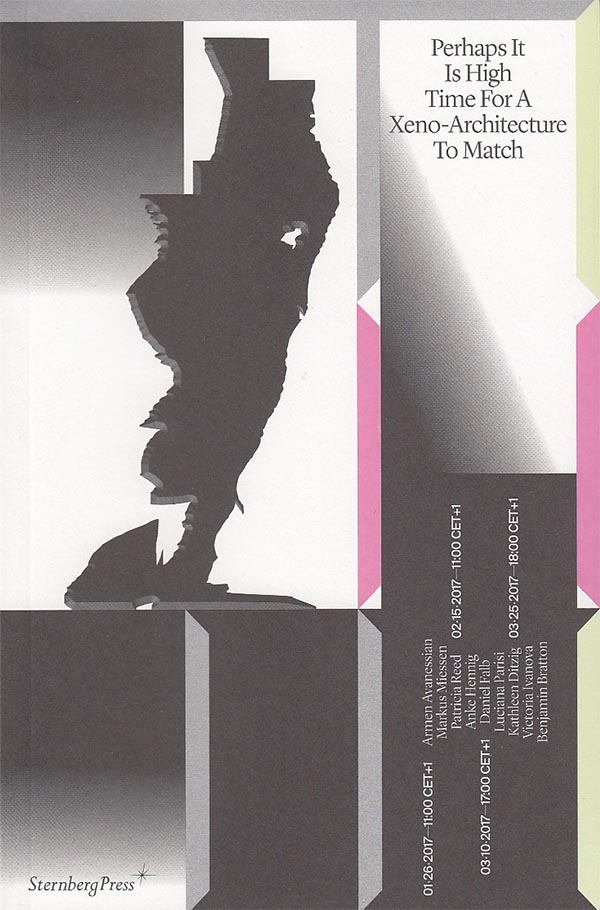
Perhaps It Is High Time for a Xeno-architecture to Match
Armen Avanessian, Lietje Bauwens and 3 more
“Xeno” speaks to the turn away from “what is” toward “what could be”: the (as yet) unknown, the alien—having been employed in recent years through such speculative-political approaches as xenofeminism and xenopoetics. Perhaps It Is High Time for a Xeno-architecture to Match documents a conversation series from January to March 2017 that explored what an intervention of the xeno might bring to bear on contemporary and future (infra)structure.
This book aims to unpack the prefix, probing what it entails—not merely rhetorically but also as a means of practice, in an attempt to bring the ideas it contains more concretely into the domain of architecture. It proposes to link the more philosophical discussions on the notion of xeno with questions of instrumentalization and governance that are necessarily involved in the praxis of architecture. And it relates the significance of legal architecture and technologically driven transformation in the metaphysics of law back to the agenda of xeno-architecture. By researching how architects, artists, thinkers, and activists operating in the spatial field might endorse a process of “alienation” to confront global issues, this project attempts to re-radicalize spatial practice.
Contributions by ARMEN AVANESSIAN, BENJAMIN BRATTON, KATHLEEN DITZIG, DANIEL FALB, ANKE HENNING, VICTORIA IVANOVA, MARKUS MIESSEN, LUCIANA PARISI, PATRICIA REED.

Wimper
Alex Farrar’s book Wimper (the Dutch term for eyelash, or a potential misspelling of the English for ‘whimper’) presently held by the reader is an extension of an exhibition, which may be experienced in its own right, after the space has been vacated. It operates on the limits of material evidence by reprising a series of earlier prints entitled Behavioural Residues (second sweep), featuring barely perceptible images of single eyelashes spread throughout the texts and pages. Apart from their significance as intimate materials discarded by the body over time, such as hair or skin, they submit to the almost nothing of an aesthetics of disappearance, while lingering in a dialectics of misunderstanding that commits to a lack of closure.
Texts by Nicolas de Oliveira and Nicola Oxley, and David Price. Graphic design by studio Hendriksen, risograph printed by Alex Farrar in studio Hendriksen, Amsterdam, with the cover offset printed by ZwaanLenoirSchuring and bound by AGIA (The Netherlands) in a print run of 300 copies.
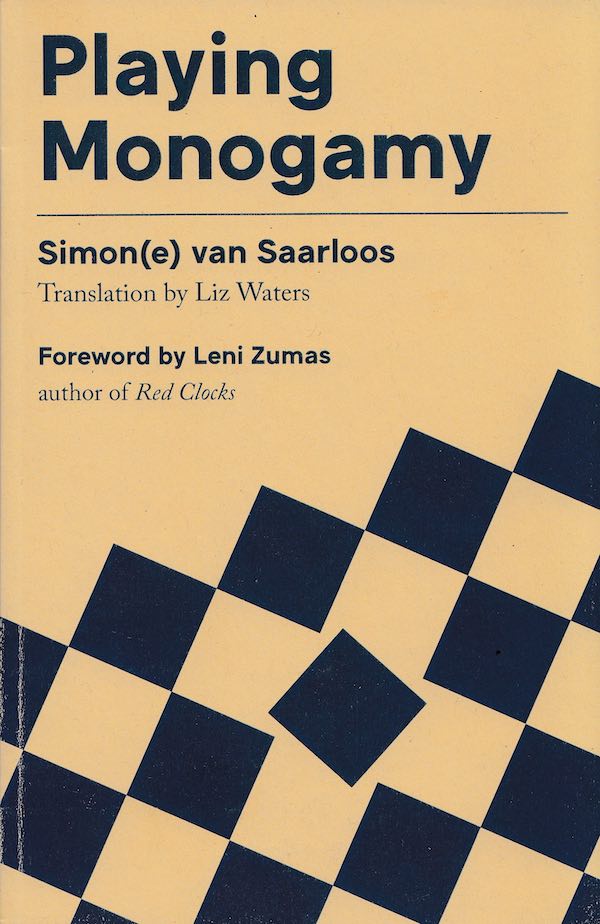
Playing Monogamy
Love is love, but not really. To recognise love as love we need comprehensible images. What are those contemporary images that help us identify love and how could we identify love differently, figuring it as less defined by safety procedures, measured commitment and feelings of ownership and entitlement? Playing Monogamy refuses to see personal relationships as safe havens where people can hide from the precarities of society, and instead proposes to make public life more intimate and romantic.
Through a contemporary rereading of the cult of monogamy, van Saarloos playfully queers the way in which the structure of monogamy is upheld through social convention within Western contexts. Written for more of a lay audience, the book proposes an expanded and polyamorous engagement with intimacy and sexuality as a possible alternative. Originally written in Dutch and published by De Bezige Bij, Publication Studio is excited to bring this book to an English speaking audience for the very first time.
Translated by Liz Waters, it includes a foreword by Leni Zumas, author of the US bestseller Red Clocks, and a revised preface by Simon(e) herself, addressing how she might approach writing about nonmonogamy differently four years after the book's first publication—and after many experiences in between.

The Baudelaire Fractal
One morning, Hazel Brown awakes in a badly decorated hotel room to find that she's written the complete works of Charles Baudelaire. In her bemusement the hotel becomes every cheap room she ever stayed in during her youthful perambulations in 1980s Paris ... This is the legend of a she-dandy's life. Part magical realism, part feminist ars poetica, part history of tailoring, part bibliophilic anthem, part love affair with nineteenth-century painting, The Baudelaire Fractal is poet and art writer Lisa Robertson's first novel.
'As far as I'm concerned, it's already a classic.' - Anne Boyer

Under Current
Companion reader for Under Current, an exhibition and film by Alice dos Reis. With 'Blue Carbon' by Holly Childs, 'Hydrofeminism: Or, On Becoming a Body of Water' by Astrida Neimanis, 'King Tide' by Sophia Al-Maria, 'Notes on a Dotted Red Wave' by Danea Io, 'Smart Oceans, Alien Times: Octopi Engineering' by Bogna M. Konior, 'To a Current's Ear' by Alice dos Reis and more. Bilingual edition (Spanish-English).

MxT
MxT, or ‘Memory x Time,’ is one of the formulas acclaimed poet Sina Queyras posits as a way to measure grief. These poems mourn the dead by turning memories over and over like an old coin, by invoking other poets, by appropriating the language of technology, of instruction, of diagram, of electrical engineering, and of elegy itself.

the project
the project - a project about love and intimacy. 'It is a method that touches on (or rather, crashes into) some (artistic) ‘taboo’s’, surrounding the ways in which the autobiographical, one’s intimate life and those who partake in that, can and ought to be dealt with within one’s artistic work. She ‘gets away with it’ and I think the reason for that is that she doesn’t try to spare herself or seek a safety zone, nor does she shun her artistic, author’s responsibility: she is constantly both in the middle of the sticky hot soup in which she is cooking her research and she doing the stirring, the spicing and the serving.' - Philippine Hoegen
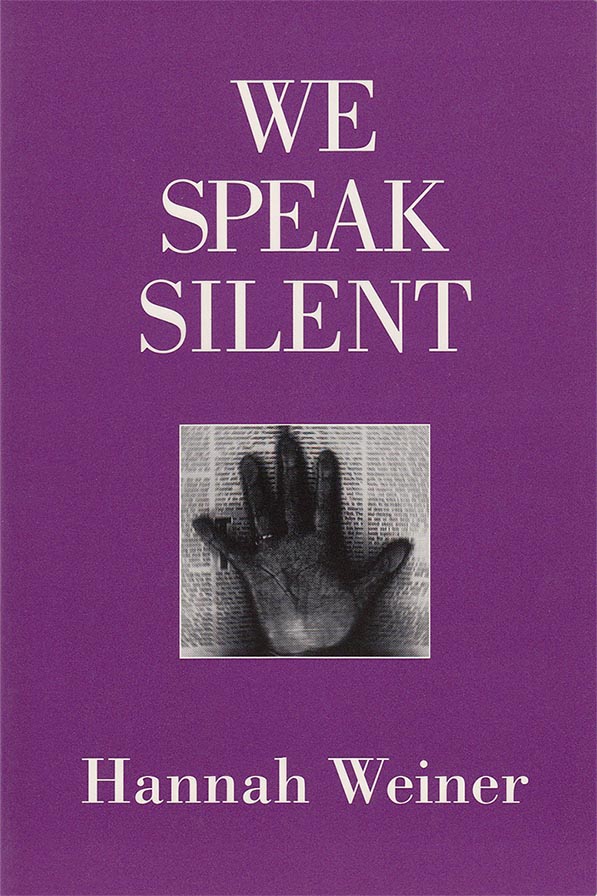
We Speak Silent
In We Speak Silent, an opus of the quirky relationships between people and their words, Hannah Weiner becomes the vessel for the emotional spectrum of the human comedy. It is a continuing adventure in language. Hannah Weiner is also the author of numerous books of poetry and prose, including The Code Poems, Clairvoyant Journal, and Little Books/ Indians.

Beyond The Periphery Of The Skin
Feminist, antiracist, trans, ecological movements: all look at the body as a ground of confrontation with the state and a vehicle for transformative social practices. Concurrently, the body has become a signifier for the reproduction crisis generated by the neoliberal turn in capitalist development and for the international surge in institutional repression and public violence. In Beyond the Periphery of the Skin, lifelong activist and bestselling author Silvia Federici examines these complex processes, placing them in the context of the history of the capitalist transformation of the body into a work-machine, expanding on one of the main subjects of her first book, Caliban and the Witch. In this process she confronts some of the most important questions for contemporary radical political projects.

Theatrum Botanicum
This publication emerges from Uriel Orlow's Theatrum Botanicum (2015-18), a multi-faceted project encompassing film, sound, photography, and installation, which looks to the botanical world as a stage for politics. Working from the dual vantage points of South Africa and Europe, the project considers plants as both witnesses to, and dynamic agents in, history. It links nature and humans, rural and cosmopolitan medicine, tradition and modernity across different geographies, histories, and systems of knowledge—exploring the variety of curative, spiritual, and economic powers of plants. The project addresses "botanical nationalism" and "flower diplomacy" during apartheid; plant migration; the role and legacies of the imperial classification and naming of plants; bioprospecting and biopiracy; and the garden planted by Nelson Mandela and his fellow inmates at Robben Island prison.
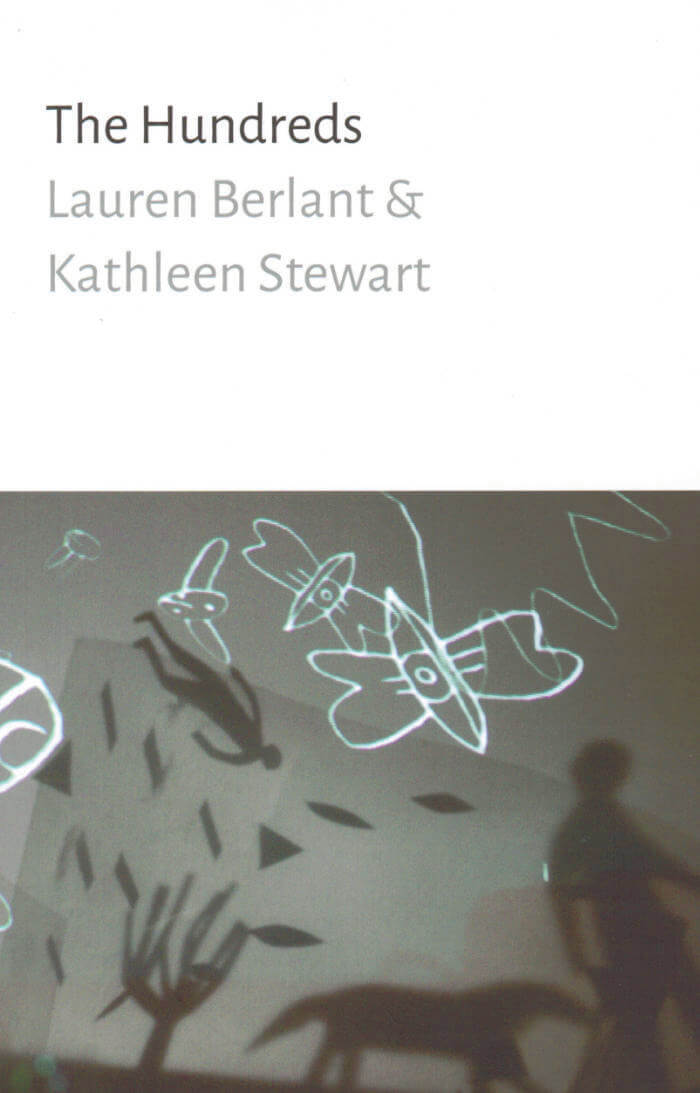
The Hundreds
Kathleen Stewart, Laurent Berlant
In The Hundreds Lauren Berlant and Kathleen Stewart speculate on writing, affect, politics, and attention to processes of world-making.
The experiment of the one hundred word constraint, each piece is one hundred or multiples of one hundred words long, amplifies the resonance of things that are happening in atmospheres, rhythms of encounter, and scenes that shift the social and conceptual ground.
What's an encounter with anything once it's seen as an incitement to composition? What's a concept or a theory if they're no longer seen as a truth effect, but a training in absorption, attention, and framing?
The Hundreds includes four indexes in which Andrew Causey, Susan Lepselter, Fred Moten, and Stephen Muecke each respond with their own compositional, conceptual, and formal staging of the worlds of the book.

Night Philosophy
Night Philosophy is collected around the figure of the child, the figure of the child not just as a little person under the tutelage of adults, but also the submerged one, who knows, who is without power, who doesn’t matter. The book proposes a minor politics that disperses all concentrations of power. Fanny Howe chronicles the weak and persistent, those who never assimilate at the cost of having another group to dominate. She explores the dynamics of the child as victim in a desensitized era, when transgression is the zeitgeist and the victim–perpetrator model controls citizens. With an afterword by Chris Kraus.